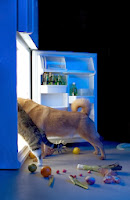By Emilio E. DeBess, DVM,
MPVM, State Public Health Veterinarian, Oregon Department of Human Services
November 2013
FDA warns about feeding
your pet a raw-food diet
In a new study, compared
to other types of pet food tested, raw pet food was more likely to be
contaminated with disease-causing bacteria, the FDA said
“The Food and Drug
Administration (FDA) is cautioning pet owners about feeding their animals raw
diets, warning that those who do may have a higher risk of getting infected
with Salmonella and Listeria monocytogenes.”
In a new study, compared
to other types of pet food tested, raw pet food was more likely to be
contaminated with disease-causing bacteria, the agency said.
The new warning was issued
after a two-year study, in which the FDA Center for Veterinary Medicine (CVM)
screened more than 1,000 samples of pet food for bacteria that can cause
foodborne illnesses.
In the study, CVM sampled
196 commercially available raw dog and cat food. The center bought a variety of
raw pet food online from different manufacturers and had the products shipped
directly to six laboratories for analysis, according to the FDA. The raw
pet-food products were usually frozen in tubelike packages and made from ground
meat or sausage.
Of the samples analyzed,
15 were positive for salmonella and 32 were positive for listeria.
The study “identified a
potential health risk for the pets eating the raw food, and for the owners
handling the product,” said Dr. Renate Reimschuessel, a researcher at CVM’s
Office of Research and one of the study’s principal investigators.
The FDA said the best way
to prevent infection is to not feed your pet a raw diet; however, the agency is
aware that some people prefer this type of food and offers some tips to prevent
salmonella and listeria:
·
Thoroughly wash
your hands with soap and water (for at least 20 seconds) after handling raw pet
food, and after touching surfaces or objects that have come in contact with the
raw food. Potential contaminated surfaces include countertops and the inside of
refrigerators and microwaves. Potential contaminated objects include kitchen
utensils, feeding bowls and cutting boards.
·
Thoroughly clean
and disinfect all surfaces and objects that come in contact with raw pet food.
You can also run items through the dishwasher after each use to clean and
disinfect them.
·
Freeze raw meat
and poultry products until you are ready to use them, and thaw them in your
refrigerator or microwave, not on your countertop or in your sink.
·
Carefully handle
raw and frozen meat and poultry products. Don’t rinse raw meat, poultry, fish
and seafood. Bacteria in the raw juices can splash and spread to other food and
surfaces.
·
Keep raw food
separate from other food.
·
Immediately
cover and refrigerate what your pet doesn’t eat or throw the leftovers out
safely.
·
If you’re using
raw ingredients to make your own cooked pet food, be sure to cook all food to a
proper internal temperature as measured by a food thermometer. Thorough cooking
kills harmful foodborne bacteria.
·
Don’t kiss your
pet around its mouth, and don’t let your pet lick your face. This is especially
important after your pet has just finished eating raw food.
·
Thoroughly wash
your hands after touching or being licked by your pet. If your pet gives you a
“kiss,” be sure to also wash your face.


No comments:
Post a Comment